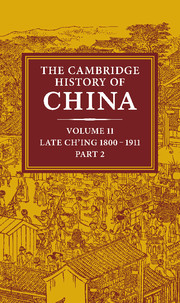Book contents
- Frontmatter
- 1 Economic trends in the late Ch'ing empire, 1870–1911
- 2 Late Ch'ing foreign relations, 1866–1905
- 3 Changing Chinese views of Western relations, 1840–95
- 4 The military challenge: the north-west and the coast
- 5 Intellectual change and the reform movement, 1890–8
- 6 Japan and the chinese revolution of 1911
- 7 Political and institutional reform 1901–11
- 8 Government, merchants and industry to 1911
- 9 The republican revolutionary movement
- 10 Currents of social change
- Bibliographical essays
- Bibliography
- Index
- Map 1. Ch’ing empire – physical features
- References
4 - The military challenge: the north-west and the coast
Published online by Cambridge University Press: 28 March 2008
- Frontmatter
- 1 Economic trends in the late Ch'ing empire, 1870–1911
- 2 Late Ch'ing foreign relations, 1866–1905
- 3 Changing Chinese views of Western relations, 1840–95
- 4 The military challenge: the north-west and the coast
- 5 Intellectual change and the reform movement, 1890–8
- 6 Japan and the chinese revolution of 1911
- 7 Political and institutional reform 1901–11
- 8 Government, merchants and industry to 1911
- 9 The republican revolutionary movement
- 10 Currents of social change
- Bibliographical essays
- Bibliography
- Index
- Map 1. Ch’ing empire – physical features
- References
Summary
CH'ING ARMIES OF THE POST-TAIPING ERA
By the end of the Nien War in 1868, a new kind of military force had emerged as the Ch'ing dynasty's chief bulwark of security. Often referred to by historians as regional armies, these forces were generally described at the time as yung-ying (lit. ‘brave battalions’). In the late 1860s, such forces throughout all the empire totalled more than 300,000 men. They included the remnants of the old Hunan Army (Hsiang-chün) founded by Tseng Kuo-fan, the resuscitated Hunan Army (usually called Ch'u-chün) under Tso Tsung-t'ang, and the Anhwei Army (Huai-chün) coordinated by Li Hung-chang. There were also smaller forces of a similar nature in Honan (Yü-chün), Shantung (Tung-chün), Yunnan (Tien-chün) and Szechwan (Ch'uan-chün). These forces were distinguished generally by their greater use of Western weapons and they were more costly to maintain. More fundamentally they capitalized for military purposes on the particularistic loyalties of the traditional society. Both the strength and the weakness of the yung-ying were to be found in the close personal bonds that were formed between higher and lower officers and between officers and men. In this respect they differed from the traditional Ch'ing imperial armies – both the banner forces and the Green Standard Army.
The Original Ch'ing banners had been composed of companies of 300 men supported by imperial stipends and grants of land. But to prevent Manchu princes and imperial officials from developing personal military power, the Ch'ing emperors had arranged in the early eighteenth century that the higher commanders of banner forces above the company level were to be rotated from garrison to garrison every three to five years.
Keywords
- Type
- Chapter
- Information
- The Cambridge History of China , pp. 202 - 273Publisher: Cambridge University PressPrint publication year: 1980
References
- 20
- Cited by

